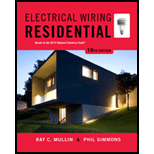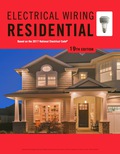
Electrical Wiring Residential
18th Edition
ISBN: 9781285170954
Author: Ray C. Mullin, Phil Simmons
Publisher: Cengage Learning
expand_more
expand_more
format_list_bulleted
Concept explainers
Question
Chapter 27, Problem 26R
To determine
Find the minimum size copper bonding jumpers that must be installed for the residence.
Expert Solution & Answer
Trending nowThis is a popular solution!

Students have asked these similar questions
Don't use ai to answer I will report you answer
Don't use ai to answer I will report you answer
Don't use ai to answer I will report you answer
Chapter 27 Solutions
Electrical Wiring Residential
Ch. 27 - Define the Service Point. ______________Ch. 27 - Define service-drop conductors.Ch. 27 - Prob. 3RCh. 27 - a. The service head must be located (above)...Ch. 27 - Prob. 5RCh. 27 - When a conduit is extended through a roof, must it...Ch. 27 - a. What size and type of conductors are installed...Ch. 27 - How and where is the grounding electrode conductor...Ch. 27 - What are the minimum distances or clearances for...Ch. 27 - What are the minimum size ungrounded conductors...
Ch. 27 - What is the minimum size copper grounding...Ch. 27 - What is the recommended height of a meter socket...Ch. 27 - Prob. 13RCh. 27 - Prob. 14RCh. 27 - Prob. 15RCh. 27 - Prob. 16RCh. 27 - Prob. 17RCh. 27 - Prob. 18RCh. 27 - Prob. 19RCh. 27 - Prob. 20RCh. 27 - Prob. 21RCh. 27 - Prob. 22RCh. 27 - Prob. 23RCh. 27 - Prob. 24RCh. 27 - Prob. 25RCh. 27 - Prob. 26RCh. 27 - Prob. 27RCh. 27 - Prob. 28RCh. 27 - Prob. 29RCh. 27 - Prob. 30RCh. 27 - Prob. 31RCh. 27 - Prob. 32RCh. 27 - Prob. 33RCh. 27 - Prob. 34RCh. 27 - Prob. 35RCh. 27 - Prob. 36RCh. 27 - Prob. 37RCh. 27 - Prob. 38RCh. 27 - Prob. 39RCh. 27 - Prob. 40RCh. 27 - Prob. 42RCh. 27 - Prob. 43RCh. 27 - Prob. 44RCh. 27 - Prob. 45RCh. 27 - Prob. 46RCh. 27 - Prob. 47RCh. 27 - Prob. 48R
Knowledge Booster
Learn more about
Need a deep-dive on the concept behind this application? Look no further. Learn more about this topic, electrical-engineering and related others by exploring similar questions and additional content below.Similar questions
- Choose the correct answer for from the following sentences: 1. The purpose of the microprocessor is to control b. memory c. processing d. tasks a. switches 2. Which of the following instructions represents base-plus-index addressing mode? a. MOV AL,[BX] b. MOV AL,[SI] c. MOV AL,BX d. MOV AL,[BX+SI] 3. The BIU pre-fetches the instruction from memory and store them in b. memory c. stack d. queue a. register 4. Which function is used to control the PWM (Pulse Width Modulation) on the Arduino output pin? a. digitalRead() b. analogRead() c. digitalWrite() 5. Which port in the PIC16F877A has an 8 external interrupt inputs? a. Port-A b. Port-C c. Port-B d. analogWrite() d. Port-D d. 4KByte 6. How much Flash EEPROM memory program found in the PIC16F877A microcontroller? a. 32KByte b. 16KByte c. 8KBytearrow_forwardSolve and select the correct answer: 2. For a random variable X with pdf: p(x) value of x is = 119 10 for -5≤x≤5. The mean (a) -75 (b) 10 (c) 0 (d) 75 3. Is the matrix A = = [1] orthogonal? Find the rank of A? 0 (a) YES, -1 (b) NO, 2 (c) YES, 2 (d) NO, -1 4. L{et sin(3t)u(t)) = (a) s-3 (s-2)²+9 2 (b) (5-3)² (c) (s-3)²+4 S-2 3 (s-2)²+9 (d) (5-2)²+9 = 5. Given that x is a constant. Choose all the correct solutions for [∞ (AB)] = (a) (AB)T (b) x ATBT (c) α BTAT (d) x (AB)Tarrow_forwardDO NOT WANT AI WILL REJECTarrow_forward
- 3. Roughly sketch the root locus for the following locations of open-loop poles and zeros. You just need to show the shape of the root locus; you do not calculate the asymptote, break-in, and break-away points. ☑ (a) (b) ☑ Φ ① $3 (c)arrow_forwardDO NOT WANT AI WILL REJECTarrow_forwardDO NOT NEED AI WILL REJECTarrow_forward
- S+4 4. Sketch the root locus for L(s) = (s+6) (s+1)2 using rules 1, 2, and 3. For rule 3, you need to find the value of σ and a for the asymptotes. From the root-locus, explain why the closed-loop system is always stable for any choice of the design parameter K in the range 0 < K < ∞o.arrow_forward2. Consider the following system. K(s+3) (s+4) (s+1)(s+2) Check whether the points below are in the root locus. If the point is in the root locus, then also find what the corresponding gain K. i) ii) -2+j3 -2+1√ √ Hint: First find L(s). Next, in L(s) replace s with the value of the point and then express it in polar format r20 using calculator. The point will be in the root locus if and only if = 180° or odd multiple of 180°. When the point is in the root locus, the corresponding gain K is obtained as K ==arrow_forwardsolve and show workarrow_forward
arrow_back_ios
SEE MORE QUESTIONS
arrow_forward_ios
Recommended textbooks for you
 EBK ELECTRICAL WIRING RESIDENTIALElectrical EngineeringISBN:9781337516549Author:SimmonsPublisher:CENGAGE LEARNING - CONSIGNMENT
EBK ELECTRICAL WIRING RESIDENTIALElectrical EngineeringISBN:9781337516549Author:SimmonsPublisher:CENGAGE LEARNING - CONSIGNMENT

EBK ELECTRICAL WIRING RESIDENTIAL
Electrical Engineering
ISBN:9781337516549
Author:Simmons
Publisher:CENGAGE LEARNING - CONSIGNMENT
Types of House Wiring - Types of Electrical Wiring - Electrical Wiring; Author: Learning Engineering;https://www.youtube.com/watch?v=A5P-buWX-dA;License: Standard Youtube License